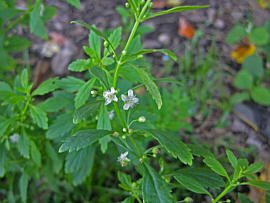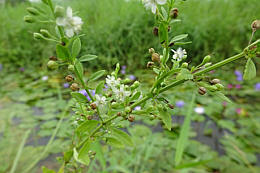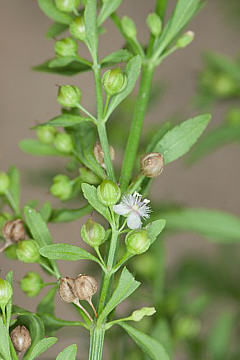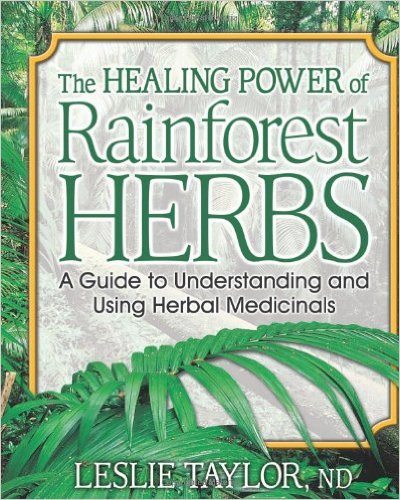Vassourinha ("sweet broom" or "licorice weed") is a small shrub of the foxglove family.
Although it can be found in USDA Zones 9 thru 11 in the U.S., it is
most abundant in South America, where in some areas it is considered
invasive. Having a long list of medicinal properties, Vassourinha
(known as "Tiatina" here in Ecuador -- which is only one of over a
120 different common names which this species possesses) is a prominent
feature of the herbal medicine practices in every tropical culture in
which the plant is found.
Uses & Protocols

In Peru and Ecuador, Vassourinha is used primarily
to treat aches, pain, cough, diarrhea, fever, headaches, hemorrhoids, infection, inflammation
and swelling, nephrosis, rash, and respirosis. In Brazil, additional indications include
abortion, bronchoses, dermatosis, diabetes, earache, gastrosis, hepatosis, hyperglycemia, jaundice,
worms, and wounds. In Ayurveda, the tea leaf is used to treat diabetes.

Its use in anticancer and antiviral formulas has been
supported by a variety of recent clinical studies.
Warnings & Contraindications

Not to be taken during pregnancy. Do not combine
with antidepressants or barbiturates unless under supervision of a qualified health practitioner.
May be contraindicated with hypoglycemia is some individuals. Diabetics: check blood glucose
levels during use to monitor effects.
Shelf-Life

Five years or more.
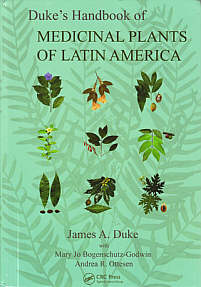
Medicinal Activities
 Further information for practitioners:
Further information for practitioners:
World-famous botanist Dr. James Duke attributes the following activities
to this plant
(p. 614-617; see hardcopy cover at right),
drawn from the extant literature. (See his graduation for "level of
efficacy" on our
amazon traditionals page;
followed by Duke's bibliographic abbreviations (in capital letters),
which we
identify
on a separate page.)

Duke provides a "
food farmacy potential" score for this
plant of "FNFF=?."
- Abortifacient (f; AUS; DAV)
- Analgesic (f1; JNP67:725; RAI; X1841990)
- Antidiabetic (1; MPG)
- Antiedemic (f; SAR)
- Antiemetic (f; RAR)
- Antifilarial (f; AUS)
- Antiherpetic (1; FNF; X11678658)
- Antiinflammatory (f1; JNP65:614; MPB; RAI)
- Antileukemic (1; RAI)
- Antioxidant (1; JMF4:179; X15900084)
- Antiplaque (1; EMP5:209)
- Antiradicular (1; JMF4:179)
- Antiseptic (f; DAV; GMJ; RAI)
- Antispasmodic (f1; GMJ; RAI)
- Antitumor (1; RAI; X11678658)
- Antitussive (f; MD2; RAR)
- Antiulcer (1; X11678658)
- Antiviral (1; RAI; X11678658)
- Aphrodisiac (f; AUS; RAI; UPW)
- Astringent (f; DAV; VOD)
- Bactericide (f1; JNP65:614; MPG; RAI)
- Beta-Glucuronidase-Inhibitor (1; X1294695)
- Cardiotonic (1; MPB; RAI)
- Cholagogue (f; GMJ)
- CNS-Depressant (1; JFM)
- Collyrium (f; GMJ)
- Contraceptive (f; AUS; DAV; SAR)
- Cytotoxic (1; FNF; X11678658)
- Decongestant (f; RAI)
- Dentifrice (f; AUS)
- Depurative (f; DAV; RAI)
- Detoxicant (f; JMF4:179)
- Diaphoretic (f; JFM)
- Digestive (f; GMJ)
- Diuretic (1; X11534346)
- Emetic (f; AUS; DAV)
- Emmenagogue (1; RAI)
- Emollient (f; KAB; VOD)
- Expectorant (f1; MPG; RAI)
- Febrifuge (f1; DAV; MPB; RAI)
- Fungicide (f1; JNP65:614; RAI)
- Gastroprotective (1; X11678658)
- H+-ATPase-Inhibitor (1; JNP65:614)
- Hypertensive (1; JNP65:614)
- Hypoglycemic (1; RAI)
- Hypotensive (1; RAI)
- Inotropic (1; X8832498)
- Insecticide (f; AUS)
- Insulinogenic (1; X15306167)
- K+-ATPase-Inhibitor (1; JNP65:614)
- Litholytic (f; RAI)
- Mucolytic (f; MPG)
- Mutagenic (1; X10052564)
- Myorelaxant (f; JNP65:614)
- Neurotropic (1: JNP67:725)
- Orexigenic (f; UPW)
- Pectoral (f; MPB)
- Pediculicide (f; JFM)
- Plasmodicide (1; AUS)
- Pulicide (f; JFM)
- Secretagogue (1; X15306167)
- Sedative (f1; JNP65:614, MPG)
- Stomachic (f; MPG)
- Sympathomimetic (1; X8832498)
- Tonic (f; JFM; RAI)
- Vermifuge (f; AUS)
- Vulnerary (f1; DLZ; RAI; WOI; X8832498)
Indications
 Further information for practitioners:
Further information for practitioners:
Duke provides the following indications for this plant:
- Ague (f; KAB)
- Albuminuria (f1; RAI; WOI)
- Anemia (f1; RAI; WOI)
- Bacteria (f; JNP65:614)
- Bites (f; JNP65:614)
- Blennorrhagia (f; KAB)
- Bronchosis (f; DAV; JNP67:725; MPB; RAI)
- Bruises (f; AUS; JFM)
- Burns (f; RAI)
- Cachexia (f; UPW)
- Cancer (1; RAI; X11678658)
- Cancer, bone (1; RAI)
- Cancer, brain (1; RAI)
- Cardiopathy (f1; JNP65:614; MPB; RAI; VOD)
- Cerebrosis (1; RAI)
- Childbirth (f; JNP65:614; RAI; VOD)
- Colic (f; MPG; RAI)
- Conjunctivosis (f; DAV; RAI)
- Constipation (f; MPG)
- Corneosis (1; X11678658)
- Coughs (f; DAV; MD2; RAI; RAR)
- Cramps (f; GMJ)
- Dermatosis (f; MD2; RAI; UPW; VOD)
- Diabetes (f1; MPB; RAI; WOI; X15306167; X15900084)
- Diarrhea (f; DAV; JFM; RAI; VOD)
- Dysmenorrhea (f1; JFM, MPG, RAI; X1841990)
- Dyspepsia (f; MPG)
- Dysuria (f; JFM; MPB; MPG)
- Earache (f; AHL; JFM)
- Eczema (f; JFM)
- Edema (f; JFM)
- Enterosis (f; JMF4:179; VOD)
- Erysipelas (f; DAV; MPB; RAI)
- Fatigue (f; UPW)
- Fever (f; DAV; JFM; MD2; RAI; VOD)
- Filaria (f; AUS)
- Fridigity (f; MPG)
- Fungus (f; JNP65:614)
- Gas (f; MPG)
- Gatrosis (f; JMF4:179; KAB; RAI)
- Glycosuria (1; WOI)
- Gonorrhea (f; AHL; JFM; RAI)
- Gravel (f; WOI)
- Headache (f; DAV; GMJ; JFM; MD2; RAI)
- Hemorrhoids (f; AHL; DAV; RAI; VOD)
- Hepatosis (f; JFM; RAI)
- Herpes (1; RAI; X2852487)
- High Blood Pressure (f1; RAI)
- Hyperglycemia (1; WOI)
- Impotence (f; RAI; UPW)
- Infection (f1; DAV; RAI; X11678658)
- Infertily (f; MD2; UPW)
- Inflammation (f1; AUS; JNP65:614)
- Insomnia (f; JNP65:614)
- Itch (f; RAI; UPW)
- Jaundice (f; JFM; RAI)
- Ketonuria (1; WOI)
- Leprosy (f; RAI; UPW)
- Leukorrhea (f; JFM)
- Lice (f; JFM)
- Low Blood Pressure (f; JNP65:614)
- Malaria (f1; AUS; JNP65:614; RAI)
- Mange (f; JFM)
- Marasmus (f; JFM)
- Melanoma (f; RAI)
- Metritis (f; DLZ)
- Metrorrhagia (f; JFM)
- Migraine (f; DAV)
- Mucososis (1; X8832498)
- Nausea (f; MD2; RAI)
- Nephrosis (f; DAV; RAI)
- Oliguria (f; RAI)
- Ophthalmia (f1; DAV; GMJ; WOI)
- Osteosis (1; RAI)
- Pain (f1; JFM; JNP67:725; MPB; RAI; VOD; X1841990)
- Pneumonia (f; RAR)
- Pulmonosis (f; JFM; RAI)
- Rashes (f; JFM; MD2)
- Respirosis (f; RAI)
- Retinosis (f; WOI)
- Snake Bite (f; RAI)
- Sores (f; JFM; RAI)
- Sore Throat (f; KAB; RAI)
- Stings (f; RAI)
- Stomachache (f; AHL; BEJ; JMF4:179; RAI)
- Stomatosis (f; JFM)
- Stones (f; RAI)
- Swelling (f; SAR)
- Syphilis (f; VOD)
- Thrush (fl; UPW)
- Toothache (f; AHL; RAI)
- Tumors (f1; RAI)
- Ulcers (1; X11678658)
- Urethrosis (f; MPB)
- Urticaria (f; MPG)
- UTIs (f; RAI)
- Vaginosis (f; MPG)
- VD (f; JFM; RAI; VOD)
- Viruses (1; RAI; X11678658; X2852487)
- Wounds (f1; DAV; RAI; SAR; WOI)
- Yellow Fever (f; JFM)
